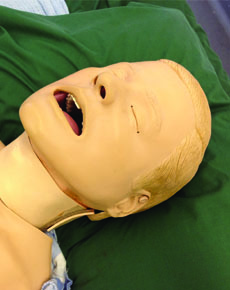Bleeding, talking mannequin takes students through their paces

He may be plastic, but the SimMan® Essential Bleeding mannequin can spurt blood, talk and scream in pain.
He’s an essential ‘member’ of AUT University’s Paramedicine team and is one of the high-fidelity human simulators used for teaching Paramedicine and Emergency Management. Using these real-life mannequins, students deal with worst-case scenarios under the guidance of a lecturer, technician and support person in an observation booth. The technician’s voice is transmitted via the mannequin, giving it the ability to speak and respond to the students’ questions.
Students can practise a huge range of procedures including how to take blood pressure, intubate (insert a tube into a person’s airway to assist breathing) and insert an intravenous drip.
Running a simulation facility is demanding, in terms of staff (three teaching staff work with two to six students) and equipment (including defibrillators and resuscitators), says Paul Davey, head of Paramedicine and Emergency Management. AUT has spent $900,000 on simulation resources over the past three years.
“The industry expects us to have a high component of simulation in our programme,” says programme leader Tony Ward. “It’s a safe practice environment that helps prepare students for the real thing”.
The simulation facility also allows AUT to offer New Zealand Resuscitation Council programmes for health professionals such as nurses, GPs and dentists who want a refresher course in resuscitation (email resuscitation@aut.ac.nz for more information).
Paramedicine changing
Paramedic education has evolved dramatically over the past 15 years from vocational-based training to one which now requires a tertiary degree in health science practice. AUT is the only New Zealand university offering a Bachelor of Health Science in Paramedicine. This year St John Ambulance stopped training paramedics in New Zealand.
An example of change is pain management says Davey. “It used to be laughing gas (entonox) or morphine. Now paramedics use morphine, ketamine, fentanyl, methoxyflurane, paracetamol and midazolam.”
Ninety-five students have just graduated, with most going to ambulance services in New Zealand. Last month the Council of Ambulance Authorities allowed AUT graduates to work in Australia where they are highly sought after for being “work-ready”, says Davey.
Next year there will be 120 first-year students (from 600 applicants), and 50 to 100 people will take part-time courses aimed at upskilling.
AUT has also started a postgraduate pathway with papers such as Aeromedical Retrieval and Aviation Physiology which cover air retrieval of a patient from a site and what happens to an injured body during flight. “A lot can happen to a person’s body at altitude,” says Davey.
Other postgrad papers included Advanced Resuscitation and Primary Health Care.